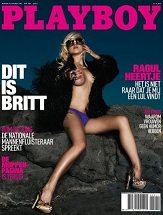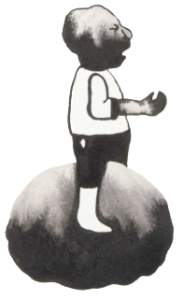 By Joran Spauwen and Jens van den Brink[1]
By Joran Spauwen and Jens van den Brink[1]
The GS Media decision[2] of 8 September 2016 is the latest chapter in the case law from the Court of Justice of the European Union (“CJEU”) on hyperlinking and copyright. Some consider it a questionable outcome with drastic restrictions on the freedom to link, and consequently of the freedom of information. Others feel the GS Media decision is merely a logical consequence of CJEU’s previous case law on the copyright holder’s exclusive right to ‘communicate his work to the public’. In any event, the decision has caused quite a stir, which may in part be due to the racy facts underlying this case.
Leaked Playboy Shots
In a nutshell, GS Media is the owner of the well known ‘shock blog’ GeenStijl.nl, which in 2011 jumped on leaked nude shots for a Playboy spread featuring a Dutch reality TV star (Britt Decker). GS Media only included links to the pictures, which were initially published by a third party through a cyber locker service. Playboy’s publisher in the Netherlands (Sanoma) sent multiple cease and desists, to which GS Media did not concede. Instead, new links were posted to other sources. Sanoma then took the case to court and requested damages and an injunction on the grounds that GS Media had not only acted unlawful, but also infringed upon Sanoma’s copyright by linking to its photos.
Hyperlinking under European Copyright
The GS Media case elaborates on the Svensson decision from 2014.[3] In that case, the Court of Justice of the European Union reached the controversial conclusion[4] that posting a link qualifies as an communication within the meaning of ‘communication to the public’, thus satisfying the first element of the right exclusively reserved to the copyright holder under Article 3(1) of the EU Copyright Directive 2001/29). Nevertheless, the CJEU found that the second element, i.e. the required public was not there when links are posted. The Court based this on prior case law requiring that such a public would have to be new compared to the public that the copyright holder considered when posting the initial publication, i.e. the content to which the link resolves. The CJEU held that in both cases the public is one and the same, since both the link and the initial publication are available to the entire online public.[5]
Dogmatically, the Svensson judgment raised several questions. The consensus was that hyperlinking falls outside the scope of copyright.[6] Moreover, it was not clear whether the CJEU´s conclusion would have been different if the copyright holder had not considered any audience for the initial publication. Most notably, when such a publication occurs without his permission. In the Bestwater judgment[7], rendered a few months after Svensson, such circumstances seemed to be at hand.[8] Again, the CJEU held that this was not a communication to the public. However, the CJEU appeared not fully conscious of the absence of permission for the initial publication. In any case it was not clear whether this had played a role.
Preliminary Questions GS Media
Not long after the Svensson and Bestwater decisions were rendered, the Dutch Supreme Court was asked to rule on the GS Media case. Both parties appealed to the Supreme Court after the Court of Appeal Amsterdam had found that GS Media acted unlawful but did not infringe upon Sanoma’s copyright. The Supreme Court considered the Bestwater judgment lacking in clarity and decided to ask preliminary questions in order to get a clear answer as to whether there is a new public if no permission has been given for the initial publication.
The new reality of GS Media
The CJEU answered the questions in GS Media affirmatively and introduced several new, partly subjective, criteria to do justice to the various interests.
First, the Court rectified the impression created by the Bestwater judgment. If content is published online without permission of the rights holder, it cannot be said that the link to this content concerns the same (internet) public as intended by the copyright holder.[9] However, this does not automatically imply that the placing of the link qualifies as a communication to the public.
The CJEU considers that it may be difficult to determine whether consent for the initial publication has been given, especially when it comes to individuals.[10] When links are posted not for profit, it should be assumed that this is done without knowledge of the infringing character of the initial publication.[11] Such links are therefore not infringing. According to the CJEU, this if different if the poster of the link is put on notice of the infringing nature of the initial publication.[12] In that case knowledge generally does exist.
For professional parties, or more specifically: parties that post a link for profit, the CJEU takes a different position. Such parties can be expected to carry out “the necessary checks to ensure that the work concerned is not illegally published on the website to which those hyperlinks lead”.[13] Therefore, the CJEU assumes that a party posting a link for profit should have knowledge of the infringing nature of the initial publication. This is presumptive evidence that can be rebutted.[14] According to the CJEU, it was (already) established in these proceedings that GS Media placed the links for profit.[15]
Consequences of judgment are not so bad/quite bad
The CJEU’s reasoning seems heavily influenced by the facts of the case. The court possibly wanted to provide course of action against GS Media in this matter under EU copyright law. It is not clear to what extent the far-reaching consequences were taken into account. In this respect it especially relevant what the decision holds in store for online media.
The CJEU devoted one paragraph to the legitimate conclusion that it may be hard to ascertain whether a link leads to an ‘illegal publication’. The CJEU suggests that there may be sublicenses, or the contents of the site may change after the link has been posted.[16] To this we add a number of obvious problems that were not mentioned in the decision:
- How can the ‘necessary checks’ be carried out? How can the linker be aware of the lawfulness of the contents on the initial publication? Does the site have to look reliable? Is it sufficient if the posted is a reputable party? Do such parties never infringe? Are websites expected to set up some sort of due diligence room for everyone who wants to link to their website – which sounds ridiculous, but in what other way could one diligently verify the consent for the initial publication?
- What if a license expires?
- What if the lawfulness of the publication of the works on the website depends on the circumstances (for example when copyright exceptions such as the right to quote apply), and what if those circumstances change?
- Normally a link refers to a page on which several works are published. Should the lawfulness of the publication of all those works be ascertained?
- What if a link is given to a website with one or more subpages, on which a work is disclosed without the permission of the copyright holder. Does the linker still have a problem then? If not, where is the limit?
In its decision, although the CJEU recognizes the problem, it adds that this is a problem “in particular for individuals”. Apparently, for parties who place links for profit, this is not – or hardly – a problem. The CJEU does not explain this difference. Possibly, a party acting for profit can be expected to have more legal knowledge and professionalism. However, it is not about the linker, but about the lawfulness of the original publication. In our experience, a party acting for profit cannot gain access to the underlying licenses more easily than an individual. The for-profit linker is in fact burdened with an impossible task.
Further, it is not clear how the profit criterion should be applied. Obviously, GS Media is an online publisher seeking to make a profit, as all media do. However, this does not mean that all links on online media are posted for profit per se. Moreover, posting a link falls under the freedom of information, protected under Article 10 of the European Convention of European Right (and Article 11 of the Charter of the European Union). According to established case law[17] the mere fact that GS Media, like almost all newspapers, broadcasters, comedians and artists, in the end indeed wants to make a profit, does not derogate from the protection offered to such parties by the freedom of expression. Aside from some empty references to the freedom of expression, the CJEU does not explain how the freedom of speech is warranted under this decision.
Naturally, it is possible that national courts (implementing the GS Media decision) will be lenient when answering the questions raised above. Furthermore, the freedom of information may have an overriding effect when it comes to applying this judgment in practice. After all, the European Court of Human Right in Ashby Donald[18] has confirmed that when enforcing copyright the interests of the copyright holder must be weighed against the interest of freedom of information. Perhaps GS Media will eventually evolve in a test that only prohibits hyperlinking to manifestly infringing content.
Nonetheless, regardless of any nuances the future might bring, the present judgment unmistakably has a chilling effect. Whoever posts a link can never rule out that he made a communication to the public of a work that was disclosed without consent, and has thus committed infringement. It seems to all boil down to the circumstances of the case. In practice one could say that from now on it is linking at one’s own risk.
This comment will appear in the upcoming MLRC newsletter
[1] Parts of this article have already been published in Dutch. Both GS Media and Sanoma are clients of the authors, who were (as a consequence) not involved in this case.
[2] See official English translation here: http://eur-lex.europa.eu/legal-content/EN/TXT/HTML/?uri=CELEX:62015CJ0160&from=EN
[3] CJEU, 13 February 2014, C‑466/12 (Svensson et al. /Retriever).
[4] For example, the CJEU ignored the advice of the European Copyright Society of 15 February 2013, Opinion on the Reference to the CJEU in Case C-466/12 Svensson.
[5] CJEU, 13 February 2014, C‑466/12 (Svensson et al. /Retriever); ground 27.
[6] In these proceedings, the Court of Appeal of Amsterdam still concluded that a link is not much different from a footnote in a book or an article in a magazine. See: Court of Appeal of Amsterdam, 19 November 2013, ECLI:NL:GHAMS:2013:4019 (GS Media/ Sanoma et al.); ground 2.4.4.
[7] CJEU, 21 October 2014, C‑348/13 (Bestwater).
[8] The BGH, which had already stated in its reference decision that there was no permission, came back to this later on; Bundesgerichtshof, I ZR 46/12 (Die Realität II).
[9] CJEU, 8 September 2016, C‑160/15 (GS Media/Sanoma et al.); ground 43;
[10] CJEU, 8 September 2016, C‑160/15 (GS Media/Sanoma et al.); ground 46;
[11] CJEU, 8 September 2016, C‑160/15 (GS Media/Sanoma et al.); ground 47;
[12] CJEU, 8 September 2016, C‑160/15 (GS Media/Sanoma et al.); ground 49;
[13] CJEU, 8 September 2016, C‑160/15 (GS Media/Sanoma et al.); ground 51;
[14] CJEU, 8 September 2016, C‑160/15 (GS Media/Sanoma et al.); ground 51;
[15] CJEU, 8 September 2016, C‑160/15 (GS Media/Sanoma et al.); ground 54;
[16] CJEU, 8 September 2016, C‑160/15 (GS Media/Sanoma et al.); ground 46;
[17] Cf. ECrtHR, 22 May 1990, NJ 1991/ 740 (Autronic v. Switzerland), and President Court of The Hague, 4 May 2011, ECLI:NL:RBSGR:2011:BQ3525 (Louis Vuitton/Plesner).
[18] ECrtHR, 10 January 2013, NJ 2015, 686 with note Hugenholtz (Ashby Donald et al. v. France).

